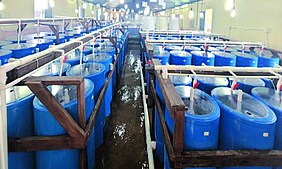The benefits of using marine protein hydrolysates (MPH) in aquafeeds have been widely documented. Previously, our team has demonstrated the advantages of incorporating a shrimp and tilapia powder hydrolysates (SPH and TPH, respectively) to restore the performance of olive flounder when fed diets with reduced levels of fish meal (Herault, et al., 2015). Additionally, the health benefits resulting from SPH supplementation in both marine fish and shrimp species were also presented in 2018, with an indication on improved resistance to bacterial diseases (Soller et al., 2018). Both studies utilised cost-effective, optimised dietary formulations that outperformed high fishmeal formulations (HFM). After these publications, numerous clinical trials were conducted on red seabream Pagrus major using SPH and TPH for internal reference purposes. Their consolidation provides further insights to better understand their potential for improving feed assimilation and the underlying modes of action.
A meta-analysis of MPH uses in different dietary contexts
Between 2014 and 2019, 16 trials were conducted at Jeju University, South Korea (Figure 1a and 1b) to assess the nutritional and health performance of new dietary solutions in red seabream, with SPH and TPH as our internal benchmarks. Both MPH were incorporated at 5% to facilitate the substitution of approximately 50% of the initial fishmeal with plant proteins, primarily soybean protein (Table 1.) depicting typical high fishmeal (HFM)and low fishmeal (LFM) formulations for red seabream. These designs provided the opportunity to evaluate the benefits of MPH in both dietary fishmeal substitution and supplementation (LFM + 5% MPH vs HFM diets and LFM + 5% MPH vs LFM diets, respectively).
After 12 to 15 weeks of feeding trials, fish were sampled to collect and measure an extensive array of zootechnical, physiological, and immune parameters. For the purposes of this study, we will specifically focus on the following parameters: specific growth rates (SGR in %/day), feed conversion ratio (FCR) and its mirror parameter; feed efficiency (FE, calculated as 1/FCR); villi length (VL in μm); enterocyte height (EH in μm) and goblet cell density (GC, number per cross section). Simultaneously with these feeding studies, apparent digestibility coefficients for dry matter (ADCDM in %) and crude protein (ADCCP in %) were assessed with fish from the same batch over a period of 3 weeks. The same dietary formulation was used, and chrome oxide (Cr2O3) served as an inert marker for ADC assessments.

